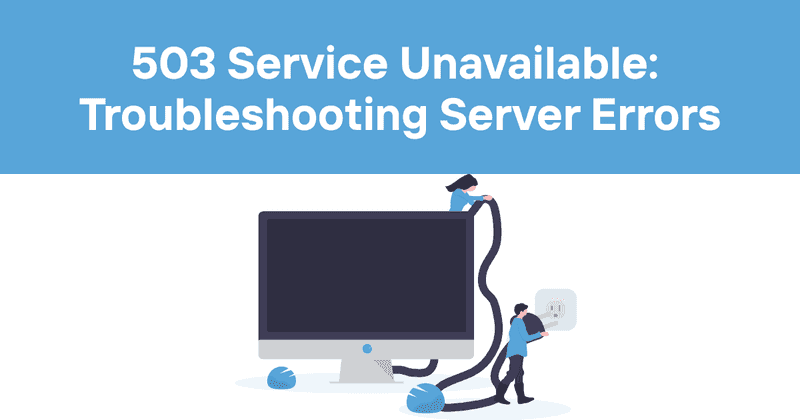503 Service Unavailable: Troubleshooting Server Errors
When you're developing or managing a website, there's nothing quite as frustrating as running into error codes that stop your application dead in its tracks. Among these unwelcome messages, the "503 Service Unavailable" error stands out as particularly troublesome because it indicates your service isn't even accessible to begin with.
I've spent countless hours troubleshooting this specific error across various platforms, and let me tell you - it can be a real headache. But don't worry. I'm going to break down everything you need to know about the 503 error, why it happens, and most importantly, how to fix it.
Table of contents
- What is a 503 Service Unavailable error?
- Common causes of 503 errors
- Diagnosing 503 errors
- Server-side solutions for 503 errors
- Client-side solutions for 503 errors
- Preventing 503 errors
- Examples of 503 error pages
- Implementing the Retry-After header
- How 503 differs from other server errors
- 503 error monitoring with Odown
What is a 503 Service Unavailable error?
A 503 Service Unavailable error is an HTTP status code that indicates the server is temporarily unable to handle the request. Unlike a 404 error (which means a resource can't be found) or a 500 error (which indicates a server processing error), a 503 specifically means the server is currently unavailable but should be available again in the future.
In plain English: the server knows you're trying to access it, but it can't process your request right now.
The HTTP specification (RFC 9110) defines the 503 status code as a server error response that indicates the server is not ready to handle the request. This is considered a temporary condition, which is why the error often includes information about when to try again.
What makes this error particularly important is that it's designed to communicate a transient issue. This means that in most cases, the problem should resolve itself after some time, unlike permanent errors that require code changes to fix.
Common causes of 503 errors
There are several reasons why your server might return a 503 error. Here are the most common culprits:
Server maintenance
The most innocent cause is planned maintenance. Administrators often set up temporary 503 responses during updates or migrations to let users (and search engines) know that the downtime is intentional and the site will return shortly.
This happens a lot with WordPress sites during updates or when making significant changes to hosting configurations.
Server overload
Another common cause is server overload. When a server receives more requests than it can handle, it might respond with a 503 error instead of slowing down to a crawl or crashing entirely.
This creates what's called "backpressure" - essentially pushing back on incoming traffic to prevent more severe failures. It's a bit like a nightclub that stops letting people in when it's at capacity.
Application pool issues
If you're running IIS (Internet Information Services) on Windows, application pool problems are a frequent cause of 503 errors. The application pool might be stopped, paused, or have identity authentication issues (like an expired password for the account running the pool).
I once spent three hours troubleshooting a 503 error only to discover it was because I had changed my Windows password and forgotten to update it in the IIS application pool. Talk about a facepalm moment.
Resource exhaustion
When critical server resources like memory, CPU, or connection pools reach their limits, many server-side applications will reject new requests with a 503 status to prevent more severe failures. This is especially common in high-traffic situations or during denial of service attacks.
Service dependencies
Modern applications often depend on multiple services. If one of these dependent services is down, your main application might return a 503 error. For example, if your web application relies on a separate authentication service that's currently unavailable, the main app might return a 503.
Rate limiting
While technically a 429 "Too Many Requests" status is more appropriate for rate limiting scenarios, some systems use 503 when specific clients are being restricted due to rate limiting policies. This is less common but worth noting.
Diagnosing 503 errors
When you encounter a 503 error, your first step should be to determine what's causing it. Here's a systematic approach:
Check server logs
The server logs are your best friends when troubleshooting 503 errors. They often contain detailed information about what went wrong. For IIS, check the following log locations:
- Event Viewer (Windows Logs > Application)
- C:\Windows\System32\ LogFiles\HTTPERR
- IIS logs folder (usually in C:\inetpub\logs\LogFiles)
For Apache or Nginx servers, check:
- /var/log/apache2/error.log or /var/log/nginx/error.log
- Application-specific logs that might be defined in your configuration
Read the logs from around the time the error occurred. Look for any error messages, warnings, or failures that might indicate the problem.
Verify application pool status (IIS)
If you're using IIS, check if your application pool is running:
- Open IIS Manager
- Click on "Application Pools" in the left navigation
- Check if your site's application pool is running (it should have a green triangle icon)
- If it's stopped, try starting it and see if it stays running
If the application pool stops immediately after you start it, check the Event Viewer for more specific error information.
Test resource usage
High server load can cause 503 errors. Check your server's resource usage:
- CPU usage (Task Manager on Windows, top or htop on Linux)
- Memory usage and available RAM
- Disk space and I/O activity
- Network connections (netstat command can be helpful)
If you see resource usage near 100%, you've likely found your culprit.
Check for URL conflicts
In some cases, 503 errors can occur due to URL reservation conflicts, especially in Windows environments. Check for URL reservations using:
If you see conflicts with the URL you're trying to use, you might need to delete the reservation with:
Verify server availability
Sometimes the issue might be with the server itself rather than your application. Try accessing other sites or services on the same server to see if they're also affected.
Server-side solutions for 503 errors
Once you've diagnosed the cause of your 503 errors, here are some server-side solutions to implement:
Application pool fixes (for IIS)
If your application pool is the culprit, try these solutions:
-
Update identity credentials: If the pool is using a specific user identity, the password might be expired or incorrect. Go to Application Pools > [Your Pool] > Advanced Settings > Identity and update the credentials.
-
Adjust Load User Profile setting: Some users report that changing the "Load User Profile" setting to "False" in the application pool settings resolves 503 errors. Be aware this might have other implications for your application.
-
Remove temporary files: Over time, IIS can accumulate files that might cause conflicts:
Remove-Item -Recurse -Force C:\inetpub\temp\appPools\*
Start-Service W3SVC
- Verify AppPool Enabled Protocols: Check the "Enabled Protocols" setting for your site/application. It should be set to "http" or "http,https" if you're using SSL.
Server resource management
If resource exhaustion is causing your 503 errors:
-
Increase server resources: Add more RAM, CPU, or disk space if your server is consistently running near capacity.
-
Implement caching: Reduce server load by caching frequently accessed content using tools like Redis, Memcached, or CDNs.
-
Configure connection limits: Adjust your server's connection limits to match your hardware capabilities. Default settings might not be optimal for your specific workload.
-
Load balancing: Distribute traffic across multiple servers to prevent any single server from becoming overwhelmed.
Module and software repairs
Sometimes 503 errors can be caused by problematic modules:
-
Repair URL Rewrite Module: After Windows updates, the URL Rewrite module in IIS sometimes needs repair. Go to Control Panel > Programs and Features > IIS URL Rewrite Module > Repair.
-
Check for missing features: In Windows Server, make sure you have all required IIS features installed. Use Server Manager to add any missing components.
-
Reinstall ASP.NET: For ASP.NET applications, try reinstalling the framework:
aspnet_regiis -i
Service dependency management
If your 503 errors are caused by dependency failures:
-
Implement circuit breakers: Use patterns like circuit breakers to gracefully handle dependency failures without bringing down your entire application.
-
Set up monitoring: Monitor all service dependencies to proactively catch issues before they affect your main application.
-
Create fallbacks: When possible, implement fallback mechanisms for critical dependencies so your application can continue functioning in degraded mode rather than failing completely.
Client-side solutions for 503 errors
While 503 errors are primarily server-side issues, there are some things clients can try:
Simple refresh
The most basic solution is simply to wait a few minutes and try again. Since 503 errors are temporary by definition, this often works.
Clear browser cache
Sometimes stale cache entries can contribute to errors:
- Use Ctrl+F5 (or Cmd+Shift+R on Mac) to force a full refresh
- Clear your browser cache completely through the browser settings
- Try accessing the site in incognito/private browsing mode
Check for local connectivity issues
Make sure your own connection isn't the problem:
- Try accessing other websites to verify your internet connection
- Reset your local network equipment (router/modem)
- Check if your ISP is experiencing outages
Use alternative access points
If possible:
- Try accessing the site from a different device or network
- Use a VPN to access the site from a different geographic location
- Use services like "Down for everyone or just me" to verify if the problem is widespread
Preventing 503 errors
Prevention is better than cure. Here are strategies to prevent 503 errors from occurring in the first place:
Load testing
Before launching a new site or feature that might attract significant traffic, conduct thorough load testing to understand your application's capacity limits.
Tools like JMeter, Locust, or k6 can simulate high traffic to help you identify potential bottlenecks before they cause production issues.
Autoscaling
Implement autoscaling for your infrastructure so it can adapt automatically to changing demand:
- Use cloud provider autoscaling features (AWS Auto Scaling, Azure Scale Sets, etc.)
- Configure container orchestration systems like Kubernetes to scale automatically
- Set up proper monitoring to trigger scaling events before resources are exhausted
Graceful degradation
Design your application to handle high load by gracefully reducing functionality rather than failing completely:
- Implement priority queues for important operations
- Temporarily disable non-critical features during peak loads
- Show simplified versions of complex pages when server load is high
Routine maintenance windows
Schedule regular maintenance during off-peak hours and communicate these windows to users in advance.
Use proper 503 responses with Retry-After headers during planned maintenance to inform both users and search engines when services will be available again.
Redundancy and failover systems
Implement redundancy in your architecture:
- Use multiple servers behind load balancers
- Set up geographic redundancy with multiple data centers
- Implement failover mechanisms to reroute traffic when issues occur
Examples of 503 error pages
When a 503 error is unavoidable, presenting a helpful error page can significantly improve user experience. Here's an example of a good 503 error response:
<!doctype html> <html lang="en"> <head> <title>Temporary Service Unavailable</title> <style> body { font-family: Arial, sans-serif; line-height: 1.6; max-width: 600px; margin: 0 auto; padding: 20px; } h1 { color: #e74c3c; } </style> </head> <body> <h1>Our site is temporarily unavailable</h1> <p>We're performing scheduled maintenance and will be back online at approximately 3:00 PM Eastern Time.</p> <p>We apologize for any inconvenience this may cause. For urgent matters, please contact our support team at support@example.com.</p> <p>Reference ID: MAINT-2025-04-15</p> </body> </html>
This example includes:
- A clear title explaining the situation
- Expected resolution time
- Alternative contact methods
- A reference ID for tracking purposes
- The Retry-After header to inform when to try again
For technical APIs, a JSON response might be more appropriate:
{ "error": { "status": 503, "title": "Service Temporarily Unavailable", "detail": "The service is undergoing maintenance and will be available in approximately 60 seconds", "retryAfter": 60, "requestId": "req-123456" } }
Implementing the Retry-After header
The Retry-After HTTP header is crucial for 503 responses as it tells clients (and search engines) when to try again. This can be implemented in two formats:
As a date-time
As seconds
The second format indicates clients should wait 3600 seconds (1 hour) before retrying.
For web servers, implementing this header is straightforward:
For Nginx
For Apache
Header always set Retry-After "3600" env=REDIRECT_STATUS=503
For IIS
And in your web.config for the Retry-After header:
Proper implementation of the Retry-After header is especially important for search engines like Google, which will respect this directive and avoid wasting crawl budget on temporarily unavailable sites.
How 503 differs from other server errors
The 503 error is just one of several server-side error codes. Understanding the differences can help with proper diagnosis:
| Status Code | Name | Description | Key Difference from 503 |
|---|---|---|---|
| 500 | Internal Server Error | General server error | Indicates a processing problem rather than unavailability |
| 502 | Bad Gateway | Upstream server returned invalid response | Usually involves proxy or gateway issues |
| 503 | Service Unavailable | Server temporarily unavailable | Explicitly indicates a temporary condition |
| 504 | Gateway Timeout | Upstream server didn't respond in time | Specifically timing-related, not general unavailability |
| 507 | Insufficient Storage | Server out of storage space | Resource constraint is specifically storage |
The 503 status code stands out because:
- It explicitly indicates a temporary condition
- It's designed to work with the Retry-After header
- It's appropriate for planned maintenance windows
- It creates less concern for search engines compared to other 5xx errors
This makes 503 the ideal status code when your service is temporarily down but will return. Using other status codes for this situation can lead to unnecessary search ranking penalties or confused clients.
503 error monitoring with Odown
Detecting and responding to 503 errors quickly is crucial for maintaining user trust and service reliability. This is where Odown's monitoring services come into play.
Odown provides comprehensive monitoring that can alert you the moment your website starts returning 503 errors, allowing you to respond before most users even notice a problem.
Uptime monitoring
Odown's uptime monitoring checks your website at regular intervals from multiple global locations, verifying not just that your site responds, but that it responds with the correct status code. If your site suddenly starts returning 503 errors, you'll be notified immediately through multiple channels:
- Email alerts
- SMS notifications
- Slack/Teams integrations
- Webhook notifications for custom integrations
This rapid notification system allows you to start troubleshooting immediately, dramatically reducing downtime and improving user experience.
SSL certificate monitoring
Many 503 errors stem from SSL configuration issues, particularly after certificate renewals or server updates. Odown's SSL certificate monitoring keeps track of your certificates' validity and configuration, alerting you to potential issues before they cause downtime.
The system checks:
- Certificate expiration dates
- Certificate chain validity
- SSL protocol and cipher compatibility
- TLS configuration security
By monitoring these aspects proactively, you can prevent many causes of 503 errors before they affect your users.
Public status pages
When 503 errors are unavoidable (such as during planned maintenance), transparent communication becomes critical. Odown's public status pages provide a professional solution for keeping your users informed.
These status pages:
- Update automatically based on monitoring results
- Allow manual updates for maintenance announcements
- Display historical uptime performance
- Provide incident history and resolution details
By maintaining a transparent status page, you can reduce support burden during outages and build trust with your users by demonstrating your commitment to service reliability.
The combination of rapid error detection, proactive SSL monitoring, and transparent communication through status pages makes Odown an essential tool for preventing and managing 503 errors. With these systems in place, you can minimize downtime, maintain user trust, and ensure that when 503 errors do occur, they're resolved quickly and communicated effectively.
Implementing a monitoring solution like Odown isn't just about catching problems—it's about building a more resilient infrastructure and providing a better experience for your users.



